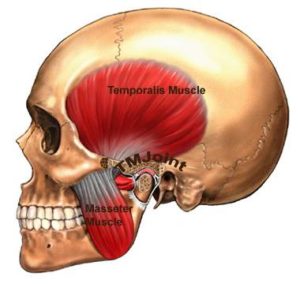Upper Cervical
Skull, atlas and axis
Upper cervical spinal care is a strict discipline within chiropractic that focuses on the upper most part of the spine (the cervical spine) where the brain and spinal cord meet to form the brainstem. Misalignment of either the skull, atlas (C1), or axis (C2) can cause neurological disturbance within the brainstem, like the fuse box of a house short circuiting.
The upper spine has the most complex alignment system of any joints in the body, and can be vulnerable to misalignment because there are no locking joints between the skull, atlas and axis. Analysis and treatment of this area is therefore more intricate.
The upper spine comprises some of the richest array of neurological input to the brain and brainstem and, as such, is the gateway between brain and body. Small misalignments, inflammation, and pain so close to the head can cause numerous problems within the central nervous system, namely:
 Headaches or migraines
Headaches or migraines- Dizziness or vertigo
- Fatigue or poor sleep
- Brain fog or moodiness
- Neck or shoulder pain
- Post concussion syndrome
- Tinnitus or ringing ears
- Poor immunity or sinusitis
- Constipation or diarrhoea
- Pain, numbness or tingling
- Movement disorders
- Balance disorders
The upper cervical spine does not usually misalign in isolation though. It, like the rest of the body, is part of a wider system that is connected to the functionality of the brain, muscles of the head and neck, gut function via the vagus nerve, and temporomandibular joint or TMJ. Therefore, analysis of upper cervical problems typically involve evaluating all systems to see the whole picture of potential causality.
Temporomandibular joint
The TMJ is a small joint in front of the ear where the skull and the lower jaw meet. This joint allows the lower jaw (mandible) to move and function, and is the most used joint in the body with eating, yawning, singing, shouting and talking.
Alterations in bite, night time grinding (bruxism), physical trauma, dental work, e.g. braces, extraction, fillings, or inflammatory disorders can all lead to TMJ dysfunction. Faults in the TMJ system with mouth opening and closing can induce problems in the cervical spine; and, cervical spine dysfunction can induce TMJ problems through head tilt and muscle spasm. Craniocervical mandibular disorders have been linked to multiple symptoms, including:
- Tinnitus or ringing ears
- Meniere’s disease
- Reduced hearing or aural fullness
- Headaches or migraines
- Dizziness or difficulty balancing
- Difficulty swallowing
- Neck and shoulder pain
- Cracking or clicking sounds in the TMJ
- Limited mouth opening or closing
- Visual disturbances
The close relationship of TMJ and upper cervical dysfunction warrants collaboration between both chiropractor, experienced in upper cervical analysis and correction, and dentist, experienced in temporomandibular disorders. Dr Neil has lectured extensively at dental conferences on the relationship between neck, jaw and brainstem, and works closely with local dentists to resolve head, neck and jaw issues.
